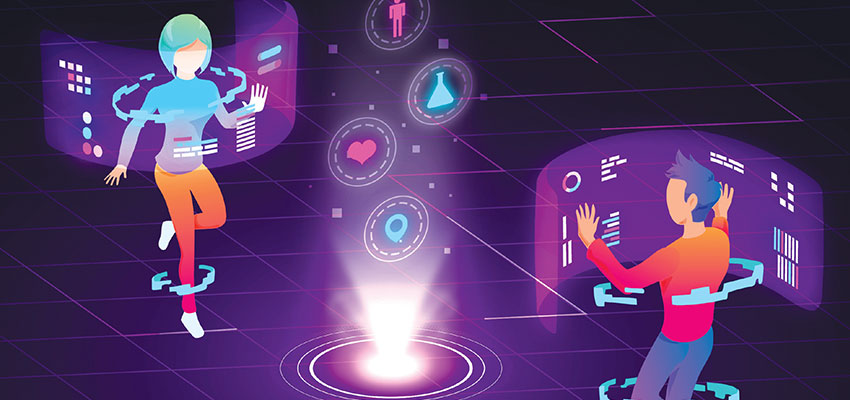AI and India’s youth capital: A high-tech romance

AI-powered medical applications can help provide timely diagnoses and treatment recommendations
-Soumya Bhowmick
The Economics of Technological Progress
The powerful advent of Artificial Intelligence (AI) with the current usage in OpenAI chatbot ChatGPT has created a stir across sectors. Only two months after its launch, the newest crown to the tech world reached about 100 million monthly active users in January 2023. Such labour-augmenting scientific innovations take us back to the 1956 Solow-Swan model of exogenous economic growth, as to how modern-day AI can increase the rate of technological progress and productivity growth in the long run. This could happen through improving the quality and quantity of output, leading to higher per capita GDP, or contributing to research and development (R&D), which can create new technologies that advance productivity rates.
What does this mean for India’s youth?
According to estimates by the World Population Review (WPR), this year is poised to be significant for the South Asian subcontinent. By mid-January 2023, India became the world’s most populous country, surpassing China (a population of 1.417 billion compared to China’s 1.412 billion). This has shifted the international focus to New Delhi’s potential to effectively utilise its vast human resources, especially the young population, to bolster its domestic economy and emerge as a prominent global player. With over 52 per cent of its population under the age of 30 and a high internet penetration rate of 43 per cent, India holds tremendous potential within the Fourth Industrial Revolution (4IR).
Advancements in tech domains such as AI, data security, data processing and transfer, and DNA editing complement the productivity across economies, especially for the young, and transform nations’ domestic and international policies. Therefore, an urgent need is to invest effectively in areas that will benefit the youth and enable sustained socioeconomic progress. Health and Education are two of the essential elements in human capital investment. By investing in these areas, India can develop a skilled and healthy workforce to drive economic growth and promote the UN Sustainable Development Goals (SDGs), especially SDG 3 (Good Health and Well-being) and SDG 4 (Quality Education).
Young people should have access to dynamic learning opportunities and investments in foundational and core work skills to embrace evolving digital opportunities fully. Firstly, with 1.2 million students out of school (mostly at the elementary level), the quality of education remains a significant challenge for India. AI can help address this issue by providing personalised learning experiences, and chatbots can provide students with instant feedback and support, allowing them to learn at their own pace. In addition, AI-powered adaptive learning platforms can also help identify areas where students struggle and provide targeted support.
Secondly, AI can improve health outcomes by mitigating India’s low doctor-patient ratio, especially in rural and remote areas. Moreover, AI-powered medical applications can help provide timely diagnoses and treatment recommendations. For example, Qure.ai, a Mumbai-based startup, has developed an AI-powered medical imaging platform that can detect abnormalities in medical scans with high accuracy. AI technology has also played a crucial role in combating the Covid-19 pandemic in India; it has been utilised for preliminary screening of Covid-19 cases, contact tracing, enforcing quarantine and social distancing, treatment and remote monitoring of Covid-19 patients, and vaccine and drug development.
The disparity in tech skills between urban and rural populations, minority groups, and across age cohorts could exacerbate the economic inequalities, leading to social unrest if appropriate measures are not taken to reskill and upskill workers
To Fear AI or Not?

The importance of governments, employers, workers, and youth in shaping skills development policies and their implementation cannot be overstated, particularly considering the opportunities and challenges presented by emerging technologies in the future of work. For example, one of the main concerns with AI is the potential medium-term unemployment due to automation. It is estimated that approximately 69 per cent of the jobs in India will be under threat due to automation in 20 years. In addition, the disparity in tech skills between urban and rural populations, minority groups, and across age cohorts could exacerbate the economic inequalities, leading to social unrest if appropriate measures are not taken to reskill and upskill workers.
Another concern is that AI-powered systems can perpetuate existing biases and discrimination, particularly against marginalised groups such as ethnic minorities, women, and people with disabilities. This could further exacerbate existing inequalities and hinder progress towards the social capital aspect of the SDGs. Additionally, using AI in sensitive areas such as healthcare, national safety, and law enforcement raises concerns about privacy and security. For example, AI-powered medical devices and applications may collect sensitive personal data, and the misuse of this data could have serious consequences.
For India, fast-track skilling initiatives will be essential in order to arrive at demand-supply equilibria in such tech-driven labour markets. It will not only enable an entire generation of livelihood opportunities, but also make the youth suitable for job markets worldwide. The Indian government has taken several initiatives to promote AI use, including establishing an Artificial Intelligence Task Force and formulating NITI Aayog’s National Strategy for Artificial Intelligence #AIFORALL. Additionally, the Ministry of Electronics and Information Technology and various state governments have taken up various AI endeavours. With the cautious implementation of initiatives in this domain, India can create a skilled workforce capable of meeting the demands of a rapidly evolving global economy, contributing to more significant economic growth and sustainable development.